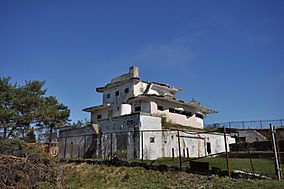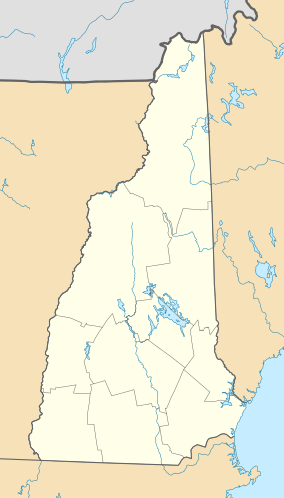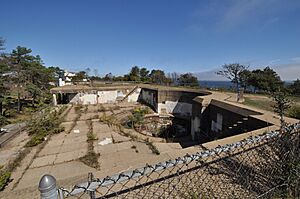Fort Stark facts for kids
Quick facts for kids Fort Stark Historic Site |
|
|---|---|

This building was a secret control post during World War II, disguised as a fancy house.
|
|
| Location | New Castle, Rockingham County, New Hampshire, United States |
| Area | 10 acres (4.0 ha) |
| Elevation | 0 ft (0 m) |
| Governing body | New Hampshire Parks and Recreation |
| Website | Fort Stark State Historic Site |
Fort Stark is an old military fort in New Castle, New Hampshire. It sits on Jerry's Point, at the very end of New Castle Island. Most of the fort you see today was built in the early 1900s. This was after the Spanish–American War. But there were even older forts on this spot, and you can still see parts of them.
The fort was named after John Stark. He was a New Hampshire officer who was very brave in the American Revolution. His most famous moment was at the Battle of Bennington. Fort Stark's main job was to protect the harbor of nearby Portsmouth. It also protected the important Portsmouth Naval Shipyard. The fort was used actively through World War II. After the war, the US Navy used it for training. In 1979, part of the fort became a state park called Fort Stark Historic Site. The rest of the land was given to the state in 1983. Today, the park is open to everyone during the day.
Contents
History of Fort Stark
Early Forts: 1700s and 1800s
The land where Fort Stark stands was first used for defense in 1746. It was called Battery Cumberland. It had nine large cannons. In 1775, during the American Revolution, the fort was rebuilt. But its cannons were soon moved to help other forts. Some cannons captured from nearby Fort William and Mary were brought here in September 1775. The fort had soldiers until 1778. It might have been called Fort Hancock during the Revolution.
In 1794, a new battery was built here. This was part of the "First System" of US forts. You can still see the remains of a round stone fort from this time. It was found in 1982.
During the War of 1812, about 120 soldiers guarded the fort. They used smaller cannons. The fort was left empty after the war ended in 1815.
In 1873, the United States bought the land. This was to build stronger defenses for the coast. Old stone forts were not strong enough against new, powerful cannons. So, plans were made for new forts made of earth. These plans included a "Battery at Jerry's Point." It was supposed to have eight huge 15-inch cannons. But money ran out in 1876, and the battery was never finished or armed. You can still see a small part of it today.
In 1898, during the Spanish–American War, quick defenses were built. Two 8-inch cannons were placed at Jerry's Point. These cannons were later moved to other forts. This made room for the new batteries at Fort Stark.
Building the Modern Fort: Early 1900s
Construction on the new Fort Stark began in 1901. It was finished in 1905. Four main batteries were built:
- Battery Hunter: Had two very large 12-inch (305 mm) guns. These guns were on special mounts that made them "disappear" after firing.
- Battery Kirk: Had two 6-inch (152 mm) guns, also on disappearing mounts.
- Batteries Hays and Lytle: Each had two smaller 3-inch (76 mm) guns on stands.
These batteries were named after brave generals from the Civil War. Batteries Hays and Lytle were mainly built to protect an underwater minefield in the harbor. This minefield would stop enemy ships. Soldiers from the United States Army Coast Artillery Corps guarded Fort Stark. The fort was part of the defenses for Portsmouth Harbor, along with Fort Foster and Fort Constitution.
Fort Stark in World War I
When the United States joined World War I, the two 6-inch guns from Battery Kirk were removed. They were sent to France to be used on the battlefield. These guns were returned to the US after the war, but they never came back to Fort Stark.
Fort Stark in World War II
During World War II, Fort Stark was still very important. In 1942, a new building was put on top of the old Battery Kirk. This building was a secret control post for the harbor. It was designed to look like a regular seaside mansion. This helped to hide its true purpose. It even had a special radar system.
Even though a new, bigger 16-inch gun battery was built nearby, Battery Hunter's 12-inch guns stayed in use until 1945. The original Batteries Hays and Lytle were closed in 1942. Their 3-inch guns were moved to another fort. A new Battery Lytle was built with two concrete pads for guns.
After the Wars
After World War II, all the guns at Fort Stark were removed. The fort was closed in 1948. In 1950, the Navy took over the fort. They used it for harbor defense until 1953. Then, it became a training center for a special Navy unit until 1980.
In 1963, two Navy 3-inch guns were placed at the "new" Battery Lytle. This was a memorial to the submarine USS Thresher (SSN-593). This submarine was lost while operating from the Portsmouth Naval Shipyard. Later, one of these guns was returned to the shipyard. The other gun was damaged in a storm in 1978.
Today, Fort Stark is a state park. It has a small museum in the Visitors' Center. You can see the remaining 3-inch gun there. Fort Stark is special because it's easy to explore. Its old buildings are well-preserved, and it has that unique secret control post building.







